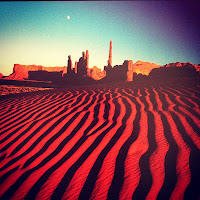You want hot? Then visit a desert. In their most sizzling months, earth’s deserts may average from 105-110 degrees Fahrenheit. Not scorching enough for you? Then plan a trip to the Sahara, which holds the record at a blistering 136 degrees. And don’t worry about finding a place to enjoy the heat; the vast Sahara sprawls over 3.5 million square miles, an area roughly the size of the United States.
How about dry?
Chile’s Atacama Desert holds the planetary record for aridity: not a single drop of rain has fallen there in more than 40 years. Many deserts rely on less than 10 inches of rain per year, with an evaporation rate 20 times the annual precipitation rate.
Still, lack of moisture does have its benefits. Antarctica’s dry polar deserts dip in temperature to an annual mean of about 1.5 degrees. In the Gobi desert of central Asia, inhabitants can expect as much as a six-month break from the heat; of course, they also have to contend with severe blizzards caused by ferocious winter winds.
Speaking of winds, gale force storms have been known to throw millions of tons of sand hundreds of miles across the earth’s deserts. Africa’s Namib Desert has built dunes as high as 800 feet (only a little shorter than New York’s Rockefeller Center, standing at 850 feet). While deserts cover 25 percent of the earth’s surface, sand accumulates on less than 20 percent of their domain. For the real king of sand, consider Mars. With an atmospheric pressure of about one-hundredths that of Earth, our red neighbor boasts three million square miles of sand – an area greater than the Empty Quarter of Saudi Arabia, the largest sand sea on our planet.
AND YET…
When God wants water, He can produce it even in the desert. “They did not thirst when He led them through the deserts,” marvels Isaiah. “He made water flow for them from the rock; He split the rock and water gushed out” (48:21). Nor is God dismayed by the heat or sand, for when He wants arid Israel to bloom, “He will make her deserts like Eden, her wastelands like the garden of the Lord” (Isaiah 51:3). He spreads a table in the desert for His people (Psalm 78:19) and promises,
“I WILL PUT IN THE DESERT THE CEDAR AND THE ACACIA, THE MYRTLE AND THE OLIVE. I WILL SET PINES IN THE WASTELAND, THE FIR AND THE CYPRESS TOGETHER, SO THAT PEOPLE MAY SEE AND KNOW, MAY CONSIDER AND UNDERSTAND, THAT THE HAND OF THE LORD HAS DONE THIS, THAT THE HOLY ONE OF ISRAEL HAS CREATED IT.”
(Isaiah 41:19-20)



















